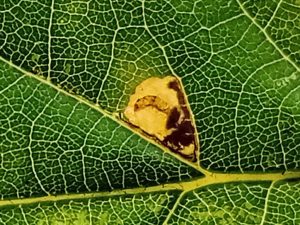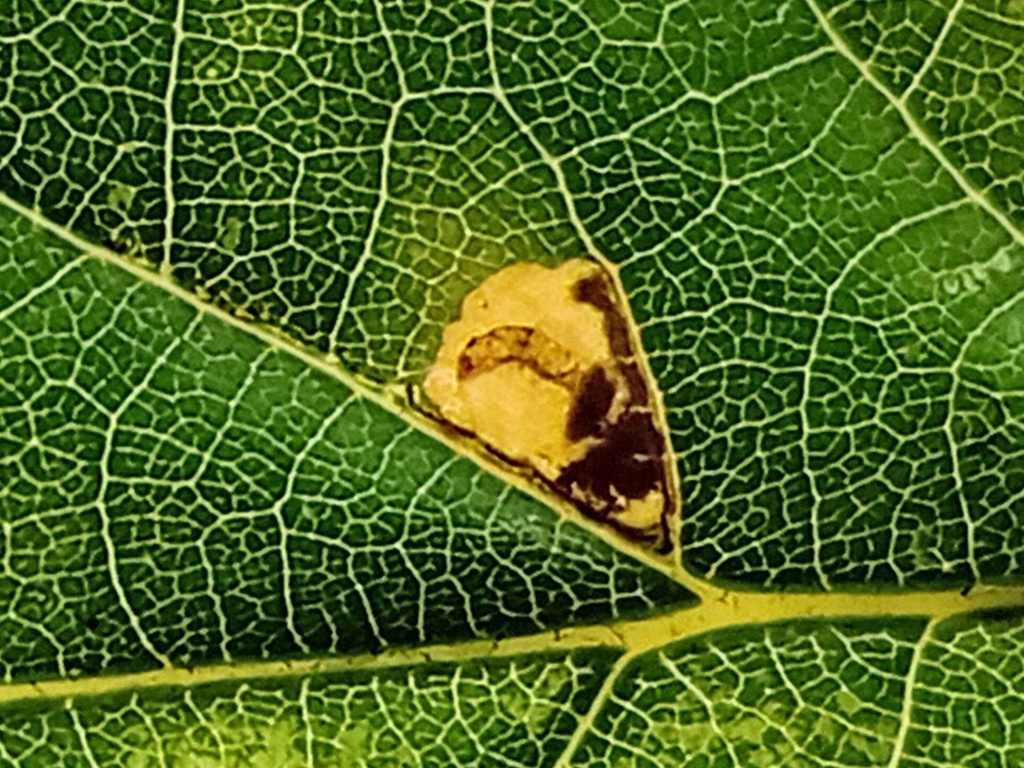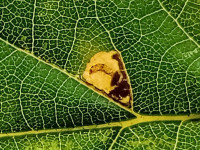 Leaf-miner: CAT L – The leaf or a Photo required –
Leaf-miner: CAT L – The leaf or a Photo required –  Larval Case: C1 – Distinctive Species –
Larval Case: C1 – Distinctive Species –  – click for General Verification Guidelines |
– click for General Verification Guidelines |  – click for Specific Verification Guidelines
– click for Specific Verification Guidelines  – Uncertain/Unknown – Insufficient Data
– Uncertain/Unknown – Insufficient Data  – Leaf Miner
– Leaf Miner
 – difficult to identify – detailed examination required, often a Gen Det and/or specimen and quality photographs are required.
– difficult to identify – detailed examination required, often a Gen Det and/or specimen and quality photographs are required.Confusion Species: Ectoedemia albifasciella – White-banded Dot ; Ectoedemia subbimaculella – Broken-barred Oak Dot
Mine Period Additional: None.
Mine ID Difficulty:
 – Care required in ID process as confusion with similar leaf mines. Quality photos of the mine required.
– Care required in ID process as confusion with similar leaf mines. Quality photos of the mine required. Mine Type/s: Gallery, Blotch
Mine Feeding Method/s: N/A
Mine Comment: The mine starts in the leaf of an Oak as a narrow and short gallery that usually runs along the leaf midrib, ending in a tenanted blotch full of brown frass. Unlike E.subbimaculella, the mine does not have a slit in the lower epidermis. The egg is on the upper-side of the leaf and the pale larva should have a reddish-brown head. The mines can be found on the ground amongst fallen leaves with “Green Islands”.
Markham Vale – 4th Nov 2025 – 1st VC57 Record – Markham Vale – Mark Radford©




Image Gallery
Distribution Map for Ectoedemia heringi
No records foundIf the Map Layers function fails, just refresh the page and it should be OK after. Use the +- zoom on the top left, or on a tablet, use two fingers to zoom. Remember, the last layer you ticked is the one which displays the popup information - they sit on top of each other - de-select then re-select, to see the popup values.
Bedrock Geology ** indirectly affects moth distribution by influencing the type of habitat and food plants available in an area. In turn, this may affect the types of moths that can thrive, or where they can most likely be found.
NBN Atlas UK Distribution for – Ectoedemia heringi
⚠️ Please wait for the map to load fully – do not click the link shown.
Note – the NBN Atlas datasets are listed in the map below and vary in their currency (uptodateness) – however,
the map does give a general indication of the moth's distribution across the UK.
Monthly Records By Year:
Ectoedemia heringi
( data includes both Larvae and Adult Stages )
Monthly Counts By Year: Ectoedemia heringi
( data is based on 'Adult' stage records only. )
First/Last Recorded Dates: Ectoedemia heringi
Adult-only & Anything [Larvae, Pupae, Adult, Mines]
Shading shows moth presence between dates
Click the colour discs below to Select/De-select as Required
Recordings By Year: Ectoedemia heringi
( All data includes both Larvae and Adult Stages )
Annual Growth Rate (AGR): Ectoedemia heringi
AGR: 0% | Total % Change: 0%
Ectoedemia heringi
Insufficient records/data for an AGR analysis
Ectoedemia heringi
Insufficient records/data for a CUSUM analysis
Hectad (10kmx10km) Coverage: Ectoedemia heringi
( data includes both Larvae and Adult Stages )
Flight Periods – Indicative –vs– Recorded Data
Ectoedemia heringi
Ectoedemia heringi
( data includes Adult Stage only )
Flight Period chart – the grey hatched area above, which can cross one or more months, pictorially represents the best guess we have for this moth's flight periods [month/s]. The coloured lines represent the actual months seen in flight, from site observation records received between 2020-2025.
Mine Periods – Indicative –vs– Recorded Data
Ectoedemia heringi
Ectoedemia heringi
( data includes both Larvae and Adult Stages )
Mine Period chart – the grey hatched area above, which can cross one or more months, pictorially represents the best guess we have for this moth's mine periods [month/s]. The coloured lines represent the actual months seen mining, from site observation records received between 2020-2025.
Records Behind the Map and Charts - Ectoedemia heringi – 0 records available
Listed by Year - descending - scroll across to see all table columns
No records found for Ectoedemia heringi.








